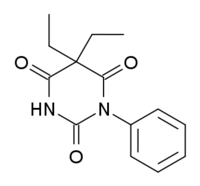Phetharbital
 | |
| Clinical data | |
|---|---|
| ATC code | none |
| Identifiers | |
| |
| Synonyms | Phetharbital |
| CAS Number |
357-67-5 |
| PubChem (CID) | 9650 |
| ChemSpider |
9271 |
| UNII |
52HG53W51E |
| ECHA InfoCard | 100.006.015 |
| Chemical and physical data | |
| Formula | C14H16N2O3 |
| Molar mass | 260.288 g/mol |
| 3D model (Jmol) | Interactive image |
| |
| |
| | |
Phetharbital (Phenetharbital) is a barbiturate derivative. It has anticonvulsant effects and relatively weak sedative action, and is considered to have a low abuse potential.[1]
References
- ↑ Eddy NB, Halbach H, Isbell H, Seevers MH. Drug dependence: Its significance and characteristics. Bulletin of the World Health Organisation. 1965;32:721-733.
| Alcohols | |
|---|---|
| Barbiturates |
|
| Benzodiazepines |
|
| Carbamates | |
| Flavonoids | |
| Imidazoles | |
| Kava constituents |
|
| Monoureides |
|
| Neuroactive steroids |
|
| Nonbenzodiazepines |
|
| Phenols | |
| Piperidinediones | |
| Pyrazolopyridines | |
| Quinazolinones | |
| Volatiles/gases |
|
| Others/unsorted |
|
See also: GABAergics | |
This article is issued from Wikipedia - version of the 4/2/2016. The text is available under the Creative Commons Attribution/Share Alike but additional terms may apply for the media files.